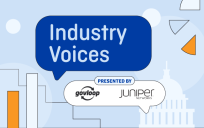Solving today’s government worker shortage is a battle that calls for fresh thinking and bold solutions. Slow hiring processes, lackluster pay, rigid policies and outdated technology are hindering government’s ability to compete with the private sector in attracting and retaining top talent. It’s time for government agencies to reimagine their approach and create a workplace that combines stability with mobility, innovation with structure, and competition with interconnectedness. We can learn a lot from how the private sector approaches these issues. Here’s how:

1. Work Flexibility
On May 11, 2023, the Biden Administration declared the end of COVID-19. Since then, agencies have been discussing ways to bring people back to the office for meaningful interactions. Yet, in recent surveys, employees increasingly say they prefer to work from home. Hybrid work arrangements are key to addressing the demand for flexibility in the when, where, and what of work. To ensure there isn’t a massive turnover rate, government agencies should adapt hybrid work environments and offer alternative workplace solutions, including work-from-home options, flexible schedules and project/task autonomy.
2. Compensation
According to the Bureau of Labor Statistics, when looking at similar responsibilities, government wage growth lags the private sector by 24 percent. It’s important to tout the benefits government employees receive more regularly than in the private sector, such as pensions, FEHB coverage after retirement, sick leave on top of vacation and paid federal holidays.
3. Lateral and Upward Growth
During the “Great Recession” many workers quit their jobs to follow their entrepreneurial dreams. While most public sector workers value stability, it doesn’t mean they aren’t ready to make bold moves in their work lives. Empowering workers to tap into their creativity and facilitating opportunities for them to grow, network and move across teams or even agencies will diversify and strengthen the overall government talent pool, attracting ambitious individuals eager to make their mark.
4. Provide Development, Skills Training and Leading-Edge Tools
For most employees, too much routinized, tedious and frustratingly redundant work becomes demoralizing. Employers should try to make the transactional parts of work — like data entry or reporting
— more automated. This will improve efficiency, give workers more flexibility and increase morale. Set aside funds to replace outdated, time-consuming legacy systems.
Additionally, job satisfaction and retention can significantly improve by providing continuous learning, skills training and the opportunity to implement leading-edge technology and innovative new programs. Empowering employees to further their training and education, then using that training with their teams, can help build a culture based on continuous improvement.
5. Lean Into DEIA Programs
Create a workplace that champions diversity, equity, inclusion and accessibility, which has been shown to improve company performance by up to 30 percent. By actively promoting DEIA initiatives, government agencies can showcase their commitment to creating a welcoming environment where all employees can thrive, while also supporting the bottom line. Focus on developing comprehensive programs that promote equal opportunities, eliminate biases and foster an inclusive culture. That can include initiatives such as implementing diverse hiring practices, providing unconscious bias training, establishing employee resource groups and ensuring fair representation at all levels.
6. Adapt to Modern Career Paths
To meet the demands of today’s workforce, government agencies should make it easier for workers to transition in and out of public service. Mapping out clear career paths that include cross-agency moves or new skill development can help attract fresh talent. Strengthening alumni programs, using special hiring authorities, and offering short-term assignments can encourage individuals who decide to leave for a time to more seamlessly return. By adapting to modern career structures and supporting career mobility, government agencies can meet the evolving needs of workers and bridge the gap between sectors.
Looking Ahead
Today, government faces complex, growing challenges as it aims to serve citizens in the most efficient responsive, and effective way possible. To meet this moment, agencies need their best “team on the field.” Yet, before they get on the field, they have to walk through the door.
In this new world of work, recruiting the best talent requires fresh thinking and bold solutions. Government agencies that change how they approach talent management to better compete with the private sector, will have an advantage securing the best and brightest talent to work on the most important challenges of our time.
Russell Miller is Director of Implementation, Government Workforce Management, OPEXUS. Russell has extensive experience providing implementation support for the HR Product Suite at OPEXUS. His expertise helps ensure products are delivered on time and on budget. He is passionate about using technology to improve the day-to-day functionality across government HR processes. In his free time, Russ enjoys Boston’s sport events, boating, and spending time with his family.





Leave a Reply
You must be logged in to post a comment.